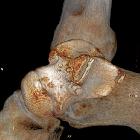Processus lateralis tali Fraktur













Lateral talar process fractures or snowboarder fractures are talus fractures that can mimic a lateral ankle sprain. It may be an isolated fracture or occur as a component of more complex ankle fractures.
Mechanism
The fracture occurs when the foot is dorsiflexed and inverted, as can happen with snowboarding (hence the term "snowboarder fracture") . A fracture should be suspected when there is soft tissue swelling inferior to the lateral malleolus.
Radiographic features
The fracture may sometimes be difficult to identify on radiographs and CT may be necessary to identify the fracture line. As many as 40-50% of fractures are missed on radiographs due to overlapping osseous structures . Ultrasound may be useful for detection, but follow up CT or MRI is necessary to further evaluate the extent of the fracture and the amount of displacement of the fragments .
Conventional radiography/CT
- fractures have been graded in a three point scale
- grade 1: uncomplicated fracture involving both articular surfaces
- grade 2: comminuted fracture
- grade 2 fractures may be further subdivided into
- 2a: <2 mm displacement of fracture fragments
- 2b: >2 mm displacement of fracture fragments
- grade 2 fractures may be further subdivided into
- grade 3: cortical avulsion fracture
MRI
- fluid-sensitive sequences: if an acute injury, there may be bone marrow edema in the lateral process
- T1: hypointense fracture line through the lateral process (fracture line and/or cortical step off may be better seen on CT)
Ultrasound
- cortical disruption of the lateral talar process (best seen with a coronal approach)
- tibiotalar joint space effusion
Treatment and prognosis
The type of treatment depends on the fracture grade :
- grades 1 and 2a: non–weight-bearing cast for 6 weeks, unless displaced or involving a significant portion of the talar side of the posterior facet, in which case they should be treated by open reduction - internal fixation (ORIF)
- grade 2b: may benefit from additional debridement
- grade 3: usually treated nonoperatively
If symptomatic nonunion occurs, debridement may be necessary.
Failure to detect the fracture may lead to nonunion, ankle instability, and accelerated osteoarthritis. The chronic fracture may then require a subtalar fusion.
Siehe auch:
und weiter:

 Assoziationen und Differentialdiagnosen zu Processus lateralis tali Fraktur:
Assoziationen und Differentialdiagnosen zu Processus lateralis tali Fraktur:
